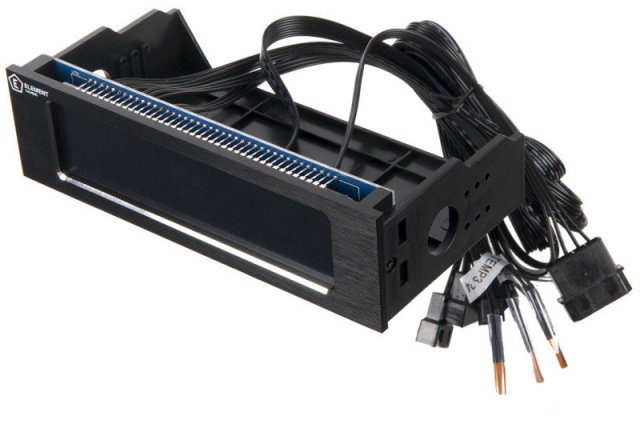
Element Gaming Temperature / Fan Controller Review
My gaming rig is housed in an Antec 1200, which allows for seven different fans (in my case, it’s made up of five Corsair Air Series and a BitFenix Spectre). Naturally, I need something to control this mass of fans because, well, I don’t want them all running at silly high speeds and messing up the air flow. My baby is a quality controlled environment, and needs protection from the harsh conditions of the outside world.
To assist with this so far I’ve been using a NZXT Sentry Mesh which can control up to five fans, leaving the BitFenix connected to the motherboard. However, Element Gaming sent us over their Temperature / Fan Controller to test out, so I popped it in my rig and gave it a spin (pun intended).
Well, I say I “popped” it in, but in reality it took about 45 minutes for reasons I’ll cover later. First though, the packaging. The controller comes in a relatively small box and is protected by two sleeves of styrofoam padding to allow safe transit without causing damage to the device. The box boasts a lot of different technical specifications, but as I read through them they didn’t exactly seem to be relevant to the average user, so here’s the long and short of it.

The device has nine cables attached: one for power (Molex), four which are used for the fans (I actually had to leave one of the fans connected to the NZXT), and four which are temperature probes. It also comes with four screws to secure it within your case, and four strips of sticky tape to secure the temperature probes. Both the fan power and temperature cables are of satisfactory length (at 60 centimeters) but the main power plug is incredibly short (at only 19 centimeters) and only just about pokes out the end of my drive bay where it’s housed. Now this is where my first dilemma arose.
Because I’m pedantic about how my computer cabling looks, I spent about five or so hours last year rerouting all of my wires, hiding them away and securing them in place. This included all of my NZXT controller wires as well. I could quite easily unplug each of the fan’s power cables and replace them into the Element Gaming one with no trouble, but the Molex power cable couldn’t get anywhere near any of my power supplies’ Molex connectors. This meant that I had to dismantle my carefully constructed perfection to reroute my Molex connectors. Whilst this may not be an issue for somebody who is building a new rig, or installing their first fan controller, for a user like myself who has things already set up, it was quite an aggravation to have to reroute everything because the power cable from the new fan controller wasn’t long enough; but I digress.
Once I’d sorted out my Molex issue, I got everything plugged in nicely and went about placing the temperature probes in various locations around my rig. Again, this was a slight issue for an already-built rig as I couldn’t easily make contact with my CPU, but for a fresh rig, this should be no hassle at all. The falling point of the temperature probes was the sticky tape provided. To make a long story short, it wasn’t sticky, so the probes escaped for their yellow cages at the first sign of freedom. It’s not a huge problem as you could quite easily replace it with higher-grade tape, but for somebody who doesn’t have this readily available, it could become an issue.

I finally got everything setup, switched on my rig, and consulted the guide supplied with the device for how to manage the fans speed and temperature. After a little bit of playing about, I managed to figure out the basics and everything seemed to work as expected. The front of the device houses an LED panel with twelve touch points to help monitor and control your computer’s internal temperature. You can switch the temperature probe gauge between Celsius and Fahrenheit, and change between the fan’s RPM and voltage output. You can also set how high each temperature probe should be allowed to reach before the controller reacts. If the temperature goes over what you have set (or a fan gets stuck/jammed), the internal buzzer will go off and alert you, whilst that specific setting will flash on the LED screen to indicate which part has the issue. There is also a handy brightness button with four settings ranging from off to full which meant I could turn the display, or dim when necessary.
My only real gripe with the interface is the internal buzzer used to indicate input on the device. It’s essentially the same as a motherboard speaker (the one you hear when you boot up your computer), and whilst this would be fine for one or two beeps, it gets quite an earful after your twentieth entry. There’s also no option to turn the speaker off, so good luck trying to silently change your fan speed at midnight.
So overall, is the Element Gaming Temperature / Fan Controller worth the £29.99 price tag? Yes, I would say it is, but only if you’re building a new rig. If you already have one built, the short power cable can become quite a large problem. Along with this, the supplied sticky tape is quite the let down. But, if you’re looking for a fan controller for four fans or less for a new rig, then you can’t go too far wrong with one.
Element Gaming Temperature / Fan Controller Review
So overall, is the Element Gaming Temperature / Fan Controller worth the £29.99 price tag? Yes, I would say it is, but only if you’re building a new rig.










COMMENTS